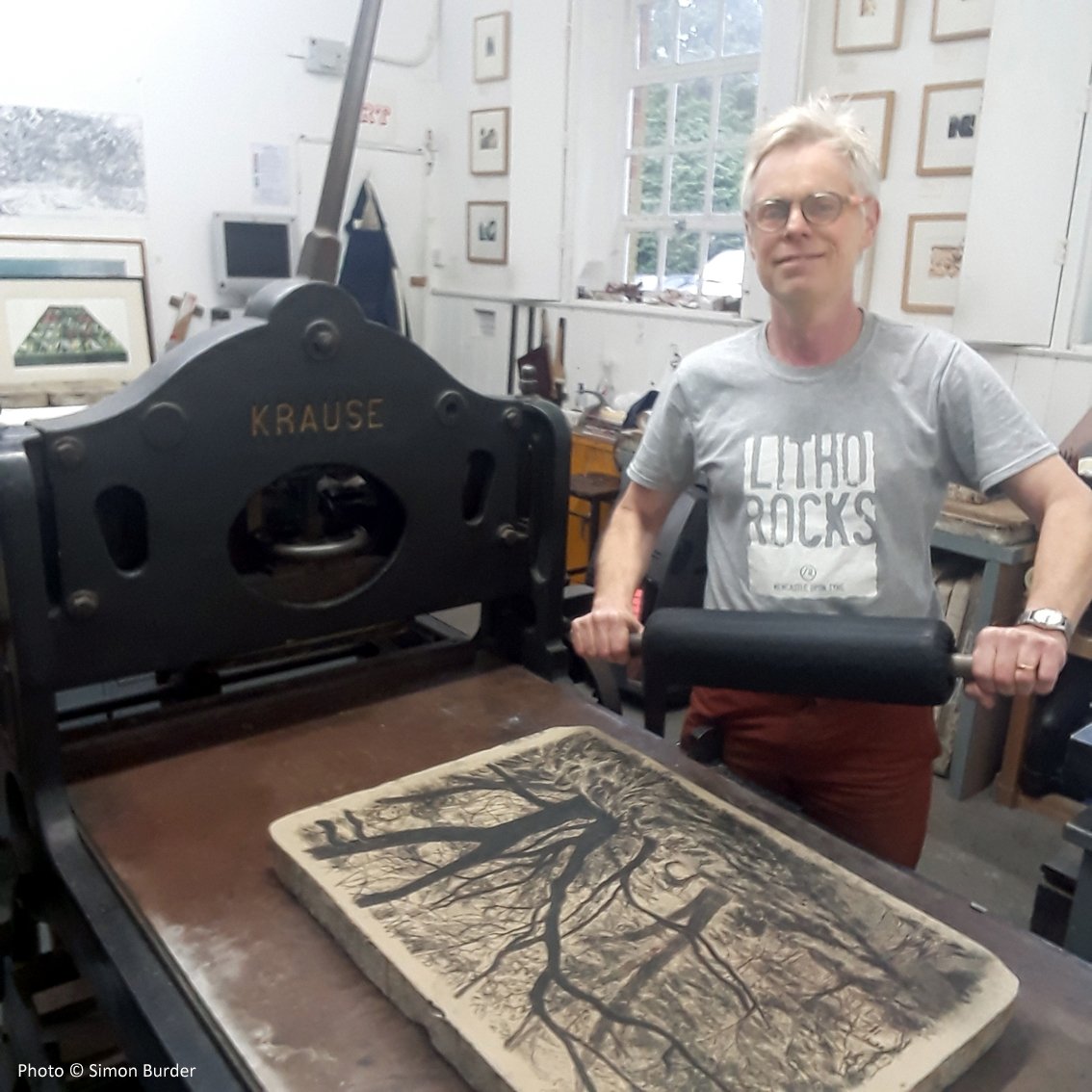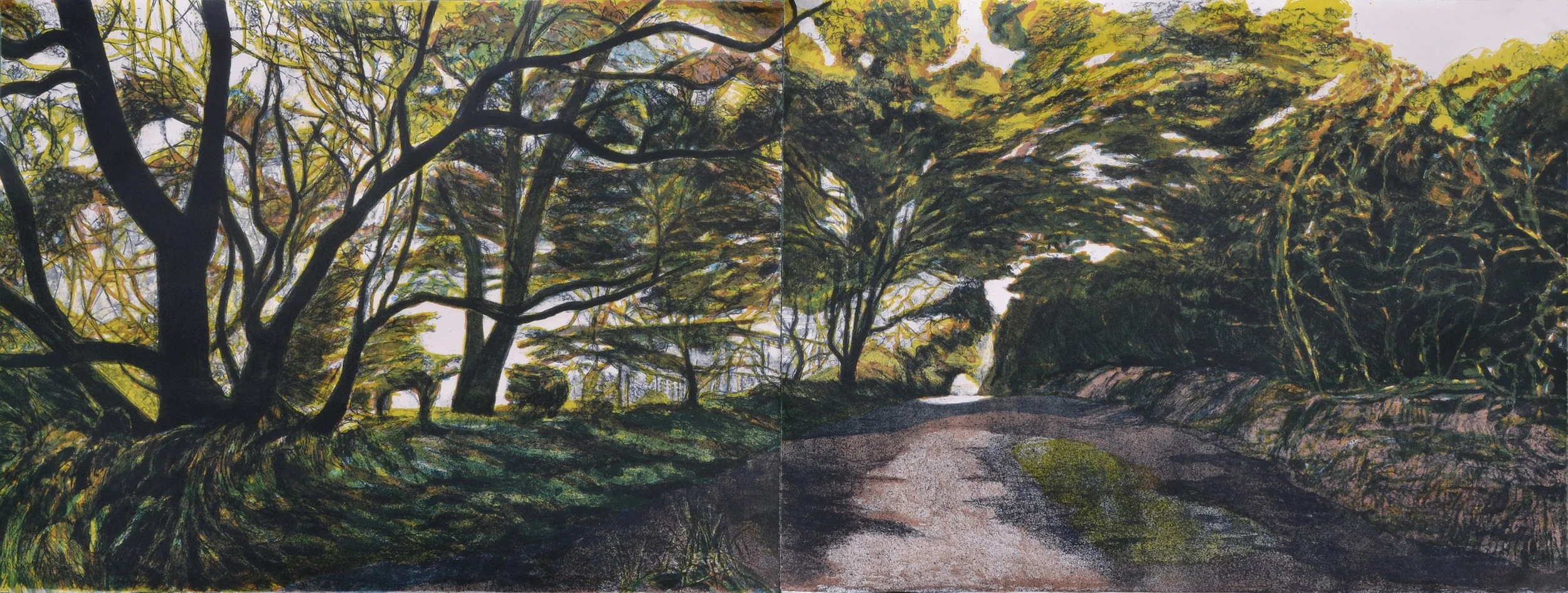Simon Burder
Describe your background. Are any of your family artists or printmakers?
Becoming an artist was almost inevitable for me. At school the art room was always my favourite place to be and I remember on a school trip to the local pottery when I was about 9 or 10 having a strong feeling of being completely at home in this kind of studio environment.
My grandmother encouraged this direction by framing all my linocut Christmas cards and her conversation was always peppered with references to her own art making as “work”, to her father who had been a professional artist and to the well-known artists she had known. But I was far from sure how to apply my general inclination towards art to a career path.
I was first introduced to lithography on my foundation course at West Surrey College of Art and Design in Farnham. Of all the printmaking processes lithography seems the most diabolical and indeed is sometimes likened to witchcraft! I wondered why anyone would go through all this pain and effort to make multiple bad copies of an already bad drawing. I thought that was the first and last time I would try lithography. How wrong I was.
When did you become a printmaker and why?
I became a printmaking student on my degree course at Exeter College of Art because I thought there were useful transferable skills to be learned, like how to make ink, while trying to figure out what on earth I was doing on a Fine Art degree.
My tutor believed etchings should only be in black and white and he didn’t think much of my efforts to make multi-plate colour etchings. He packed me off to the lithography department in another part of town, where it was acceptable and we were encouraged to make colour prints.
What is your preferred medium and why?
I was soon hooked on printing lithographs from zinc plates on an offset litho press and on the prints of late 19th century French artists such as Toulouse-Lautrec and especially Bonnard and Vuillard.
The colour and layered construction as well as their assuredness but looseness of execution appealed, as well as their social commentary themes. They played an important part in my attraction to Paris as a place to study lithography and the kind of mostly figurative and urban imagery I made at that time.
I was seduced by the versatility of the process that can mimic any kind of painting and drawing technique, as well as the magic that happens, actually through the chemical principle that oil and water do not mix.
I tried stones first at Exeter, then applied for a French Government Scholarship to attend the Ecole des Beaux Arts in Paris and the addiction became permanent.
After my return from France, I tried to build my career, with false starts and dead ends at first. But the doors that opened for me always lead to making more lithographs, first as a member of Glasgow Print Studio, then employed in the printmaking department of Wimbledon School of Art for a good number of years, then teaching in a variety of art schools, colleges and community print workshops and setting up my studio at Oaks Park in 1995.
Here I not only make my own prints, but I also love helping artists to learn and use lithography for themselves, through offering courses and studio access, and collaborating with edition printing. During a working holiday in Pembrokeshire, south-west Wales, I started drawing rocks. It was a turning point from the earlier work, which had been mostly focussed on people in an environment, and the beginning of a new focus on landscape, particularly where there is evidence of human activity.
People disappeared from my images, but there is still a sense that they are around somewhere nearby. I am interested in the places where they live, work, travel. Paths, roads and canals, harbours, sites of industrial archaeology and buildings such as farms and churches continue to be my inspiration. The theme of journeys emerged as significant in my work, both actual and metaphorically of the spiritual life.
I started to use a panoramic format to try to include as much of my view as possible and to work in series of connected images, suggestive of frames of a movie - movement, a journey in time.
For one of my prints, Daymer Path, I used two of my largest stones, about 20 x 28 inches and 21⁄2 inches thick. They are heavy but I can just about pick them up, so lithography definitely keeps me fit! I bleed printed the image to eliminate the restriction of white paper margins, making it feel more all-enveloping, as if you are actually in the picture. The final size of the image on two sheets of paper joined together is 18 x 48 inches.
My current Woodmansterne Road series started with 21 drawings from photos, taken from the passenger seat of a car. The film connotations are more obvious, the car was travelling along a stretch of road next to Oaks Park where I have my studio.
I am drawn to the sculptural qualities of the space as I travel through, the glimpses of beyond through the trees and hedges that line the edge of the road. I draw with less detail to keep a sense of movement or even speed.
Someone I know told me the drawings make him feel what he experiences when he cycles home along this same road. When I make the lithographs, I am also remembering the changing colour and light in all the different times of day, season and weather in which I have travelled down this road. Printmaking is ideal for this exploration of alternatives.
If your house was burning down what would you save?
Too many lovely artworks to choose between or carry.
www.oaksfineart.co.uk
www.instagram.com/oaks.editions





Daymer Path


